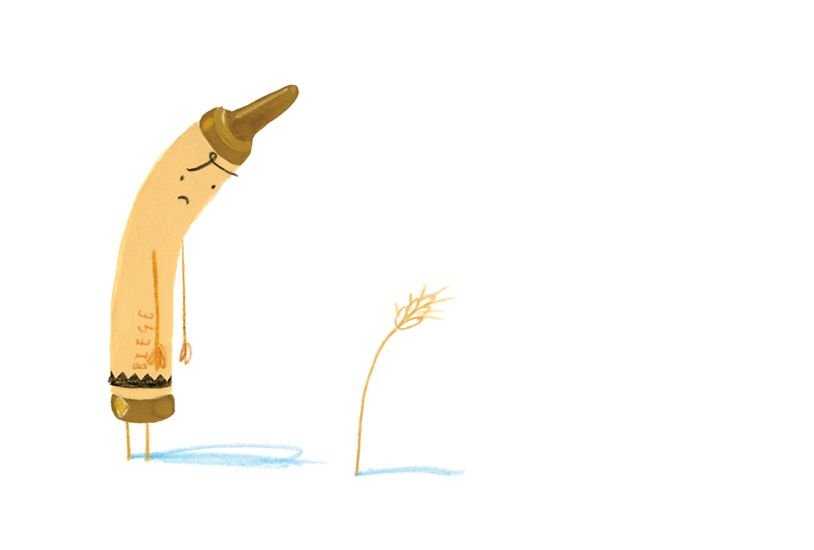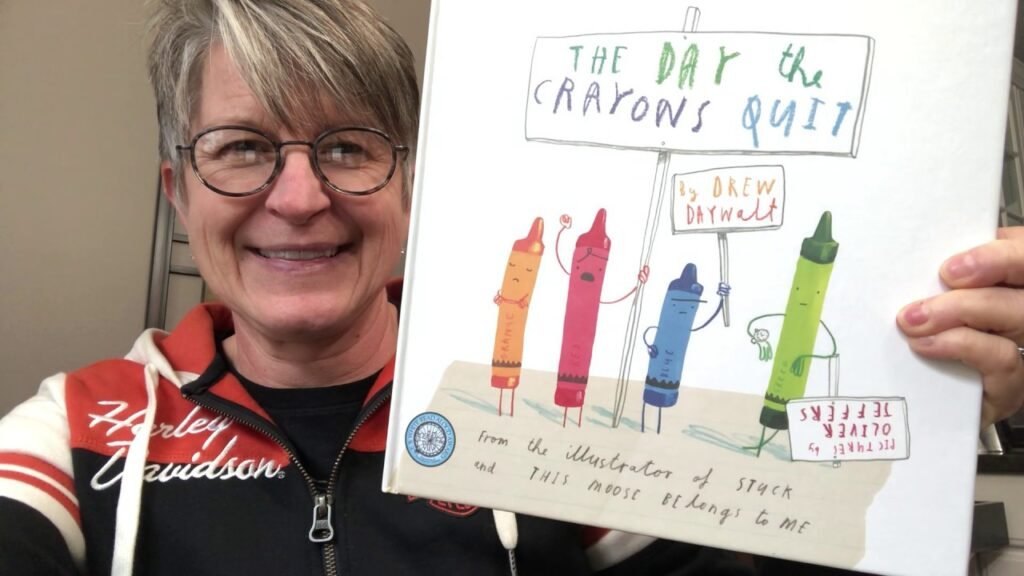“The Day the Crayons Quit” is a charming and imaginative children’s book written by Drew Daywalt and illustrated by Oliver Jeffers. This delightful story introduces readers to a unique conflict – a set of crayons that decide they’ve had enough. They’ve been used, overused, and in some cases, completely ignored. Rather than keeping their frustrations to themselves, the crayons decide to write letters to their owner, a young boy named Duncan, explaining their grievances. Each crayon has its own distinct personality and a letter filled with complaints about their roles in the crayon box.
The genius of “The Day the Crayons Quit” lies not just in the humorous premise but also in the way it allows children to explore emotions like frustration, miscommunication, and the importance of resolving conflicts. The crayons express their thoughts openly, making it a perfect way to introduce kids to the idea of communicating their feelings and negotiating solutions.
Through witty letters and colorful illustrations, this book teaches valuable lessons on self-expression and empathy. “The Day the Crayons Quit” has become a favorite in classrooms and homes alike, offering both entertainment and educational value for young readers.
Plot Summary of “The Day the Crayons Quit”
The story of “The Day the Crayons Quit” revolves around a box of crayons, each with a personality, who are fed up with the way they’re being used. The crayons each write a letter to Duncan, the boy who owns them, explaining their individual complaints and frustrations.
Red Crayon is tired of being overused for fire trucks, apples, and hearts on Valentine’s Day. Blue Crayon, on the other hand, feels neglected because it is only used to color large, blue objects, making it feel underappreciated. Pink Crayon is upset that it is used only for “girly” things like princesses and flowers. Green Crayon is worn out from coloring all the grass, while Yellow and Orange Crayons are having an ongoing argument over which one is the true color of the sun.
In each letter, the crayons offer a glimpse into their emotional states, asking Duncan to address their concerns and find a way to restore balance. Duncan reads the letters and realizes how important it is to consider the needs of each crayon. By the end, Duncan comes up with a creative solution, allowing each crayon to shine in their own way, ensuring that no crayon feels neglected or overused.
The beauty of this story lies in its simplicity and how it encourages children to think about empathy, communication, and how everyone’s feelings deserve attention.
Characters in “The Day the Crayons Quit”
The characters in “The Day the Crayons Quit” are, of course, the crayons themselves. Each crayon has its own distinct personality, which is conveyed through their letters to Duncan.
Red Crayon is bold and fiery, but also tired and overworked. It represents the color of passion, but it is often used so much that it feels taken for granted. Blue Crayon is calm and cool but feels overshadowed by the demand for other colors. Green Crayon is full of life but overburdened by the task of coloring all the grass and trees in Duncan’s drawings. Meanwhile, Yellow and Orange Crayons argue with each other over the sun, each convinced that their color is the true shade of sunlight.
Other crayons, like Pink and Purple, express their unique concerns, with Pink Crayon lamenting being associated only with “girly” images and Purple Crayon feeling slightly less popular compared to other colors. There’s even a very tiny, well-meaning, but somewhat forgotten Beige Crayon, who often feels overshadowed.
Through these characters, “The Day the Crayons Quit” gives young readers the chance to explore different viewpoints and the importance of addressing conflicts openly. The personalities of each crayon help make the story both entertaining and educational, showing that everyone has their own needs and feelings.
Themes and Messages in “The Day the Crayons Quit”
At its core, “The Day the Crayons Quit” is a story about communication, empathy, and creativity. Each crayon expresses its frustrations, which serve as an excellent lesson for children on how to talk about their own feelings and resolve misunderstandings.
One of the central themes in the book is the importance of self-expression. Each crayon is unique and has a specific role to play in Duncan’s artwork, but they feel unappreciated because their needs have been overlooked. By allowing the crayons to express their frustrations in letters, the book emphasizes the value of listening to others and recognizing their emotions.
Another important theme in the book is the power of creativity. Duncan, in the end, resolves the crayons’ complaints by finding new ways to use them. This reinforces the idea that creativity can help solve problems and make everyone feel included. It shows children that with a little imagination and flexibility, they can find solutions to challenges that may seem difficult at first.
Finally, the book teaches empathy. As the crayons reveal their feelings, Duncan learns to understand each crayon’s perspective. This encourages children to put themselves in others’ shoes and recognize that everyone’s feelings are valid, even if they are different from their own.
Illustrations and Artwork in “The Day the Crayons Quit”

The illustrations in “The Day the Crayons Quit” are a crucial part of the book’s appeal. Created by Oliver Jeffers, the artwork complements the humor and depth of the story. Each crayon’s letter is paired with a drawing that reflects the crayon’s personality and emotional state. The visual elements help bring the characters to life, making them more relatable to young readers.
The style of the illustrations is playful and vibrant, matching the lively personalities of the crayons. Jeffers uses a mix of simple line drawings and colorful backgrounds, which makes the story easy to follow and visually engaging for children. The crayon box itself is often depicted as a chaotic mess, reflecting the disarray caused by the crayons’ complaints.
The artwork also provides subtle details that enhance the narrative. For example, in Red Crayon’s letter, the page is filled with bold, fiery red hues, while Blue Crayon’s letter features a cooler, calmer tone. These visual cues help children connect with the emotions being expressed, making the story even more immersive.
Ultimately, the illustrations in “The Day the Crayons Quit” elevate the book from a simple tale to an engaging and interactive experience, helping children better understand the book’s themes.
Reception and Popularity of “The Day the Crayons Quit”
Since its release, “The Day the Crayons Quit” has garnered widespread acclaim and become a favorite in classrooms and libraries around the world. Its clever premise and relatable characters have made it a hit with both children and adults. The book has received numerous awards, including the E.B. White Read-Aloud Award, and has been translated into many languages, making it accessible to a global audience.
Parents and teachers appreciate the way the book addresses emotional intelligence and conflict resolution. It offers a fun way to introduce children to important life skills, like listening, empathy, and creativity. The humor and whimsy of the story also make it highly enjoyable for adults to read aloud, creating an interactive experience for families.
In addition to its literary success, “The Day the Crayons Quit” has inspired various spin-offs, including “The Day the Crayons Came Home”, which continues the story of Duncan’s crayons. This sequel, along with merchandise and other adaptations, has helped the story maintain its place as a beloved children’s classic.
Educational Value of “The Day the Crayons Quit”
“The Day the Crayons Quit” is not just a fun story; it also serves as a valuable educational tool. The book teaches children about emotions, conflict resolution, and the importance of creative expression. It can be used in classrooms to spark discussions about feelings, the role of creativity, and how to handle disagreements.
The crayon characters provide a way for children to explore different perspectives, making it easier to discuss empathy and communication. Teachers can use the book to encourage students to express themselves through writing, whether it’s by creating their own letters from different colors or brainstorming new ways to use crayons.
Parents can also use the book at home to engage their children in conversations about teamwork and problem-solving. The playful nature of the book helps make serious topics like empathy and conflict resolution feel more approachable.
Ultimately, “The Day the Crayons Quit” offers a wonderful mix of fun and educational value, making it a must-read for young readers and a fantastic tool for learning.
FAQs:
- What is “The Day the Crayons Quit” about?
- It’s a children’s book where crayons write letters to their owner, expressing their frustrations and asking for changes.
- Who are the main characters in “The Day the Crayons Quit”?
- The main characters are the crayons, each with their own personality and unique complaints, including Red, Blue, and Yellow Crayon.
- What themes are explored in “The Day the Crayons Quit”?
- The book explores creativity, communication, empathy, and the importance of resolving conflicts.
- Who illustrated “The Day the Crayons Quit”?
- The book was illustrated by Oliver Jeffers, whose playful art style complements the story’s humor and themes.
Conclusion
“The Day the Crayons Quit” is a heartwarming and entertaining story that teaches valuable lessons about creativity, communication, and empathy. Through the letters of the crayons, young readers are encouraged to think about their own emotions, the importance of listening, and the power of finding solutions to problems. With its playful illustrations and relatable characters, the book continues to be a beloved classic, helping children understand and express their feelings in a fun and engaging way. Whether read at home or in a classroom, “The Day the Crayons Quit” remains a must-have for every child’s bookshelf.



